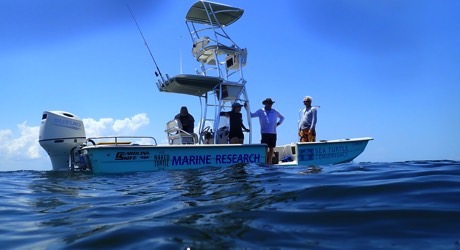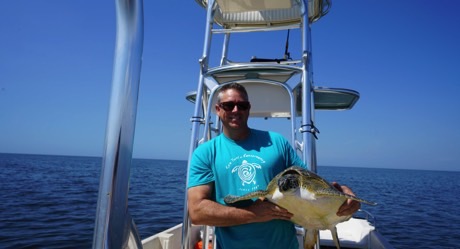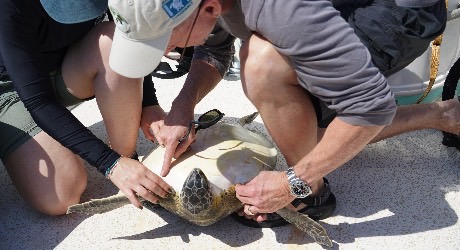Sea Turtle Conservancy (STC) has been monitoring and protecting critical nesting beaches for endangered green turtles and Kemp’s ridley turtles for decades. The primary nesting site for green turtles in the Western Hemisphere is at Tortuguero, Costa Rica. The main nesting site for Kemp’s ridleys is located in Rancho Nuevo, Mexico. These coordinated efforts have stopped the decline of these species and both populations are showing signs of recovery.
However, it’s just as important to monitor and protect sea turtles in the ocean at their foraging sites. Green and Kemp’s ridley sea turtles are highly migratory and spend decades foraging for food in shallow water. The northern Gulf of Mexico provides crucial developmental habitat for young sea turtles that were originally hatched from all over the Wider Caribbean.
Unfortunately, there are no systematic monitoring and conservation programs in place to track these in-water populations and address growing threats, such as debris entanglement, habitat degradation, commercial fishing, boat strikes, diseases related to water quality, and climate change. These threats must be understood and reduced in order to ensure that decades of conservation work is not lost.
Key Project Activities
STC began an in-water research and conservation program in 2018 (with start-up support from World Nomads) in the northern Gulf of Mexico that focuses on population monitoring, collecting biological information, tracking fine-scale movements, rescuing sick or injured turtles, and communicating with stakeholders to reduce negative sea turtle interactions.
During the initial phase of this project, STC surveyed over 1,200 km of coastal habitat and identified major “hot spots” for sea turtles in the northern Gulf. This report shares results on the second phase of this project (also supported by World Nomads), which was initiated in 2019 and included: 1) a capture-mark-recapture program to collect important biometric data about the sea turtles found in this region; 2) a satellite-tracking program to study the fine-scale movements and habitat use of representative individuals from the population; 3) a rescue effort to recover sick and injured turtles for transport to nearby turtle rehabilitation facilities, and 4) a public outreach campaign targeting commercial and recreational fishing communities in the region, with the goal of reducing interactions between turtles, boats and fishing gear.
Key Project Outcomes
Despite some difficulties due to the COVID-19 pandemic, STC spent 44 days on the water since 2019 capturing sea turtles from our research vessel. Key outcomes and discoveries included:
- Tagged, measured, tissue sampled, and photographed 173 sea turtles in three study sites in the northern Gulf of Mexico.
- Juvenile green turtles make up the majority of the sea turtles, which four decades ago had been nearly wiped out due to over-harvesting.
- Captured juvenile green turtles ranged in size from 27.8 cm to 78.7 cm straight carapace length (SCL) with a mean of 47.9 cm SCL.
- Of the captured green turtles, 56% had tumors associated with the disease fibropapillomatosis (FP), with 11% showing severe signs of FP.
- A small proportion of green turtles had evidence of boat strikes or line entanglement (2%).
- Three sea turtles were recaptured during this period (two green turtles and one Kemp’s ridley) and all showed positive growth rate trajectories.
- We attached 23 satellite transmitters to green turtles during 2019 and 2020. Eighteen turtles transmitted location, depth and water temperature data from the fall into the spring months (78%), allowing us to identify previously unknown overwintering sites and relatively high site fidelity at non-winter sites.
- One underweight green turtle with severe FP was rescued and sent to a Florida rehab facility.
- Work in the last three years will result in at least 4 scientific publications, establishing this relatively undeveloped coastline as one of the most important sea turtle foraging grounds in the northern Gulf of Mexico.
Community Involvement
In conjunction with research trips, STC interacted with visitors and residents in the small fishing towns of Florida’s northern Gulf coast. Many of them shared stories of seeing sea turtles while fishing and told us where they thought we might find them. Some of the older residents remember a time when they and their relatives hunted green turtles for meat and wondered if they would be able to do this in the future. Each year, STC interacted with 50 to 75 individuals along the coast. Most were excited to see STC involved in sea turtle research and conservation in the region.
Additionally, STC involved local biology students from the University of Florida in the research and conservation project. By including local students in the program, STC expanded our educational reach and gave aspiring biologists outstanding field research experience that will help guide their academic and professional careers—hopefully inspiring some to focus additional work on the conservation of sea turtles.
What's Next?
STC’s in-water research, monitoring, and conservation program in the northern Gulf has a strong foundation for the future. STC is partnering with local universities and state agencies on multiple research and conservation initiatives. This includes new research on vessel strikes, diseases, health assessments, and water quality issues. In addition, STC is developing a small information card to distribute to visitors and residents along the coast, primarily to educate them on the importance of the northern Gulf to sea turtles and what they can do to help.
Large portions of Florida’s northern Gulf are still relatively undeveloped and scenic. However, STC expects this to change in the coming decades as new freeways are being planned and coastal development pressure increases in the region. This will likely impact the habitats that the sea turtles depend upon and, in turn, affect the sea turtles themselves. STC’s research and conservation along this coast will allow us to work toward a healthy future for these important sea turtle populations even in the face of increasing pressure from humans.
Project background
Sea Turtle Conservancy has been monitoring and protecting critical nesting beaches for endangered green turtles and Kemp’s ridley turtles for decades. The primary nesting site for green turtles in the Western Hemisphere is at Tortuguero, Costa Rica, where STC has worked since 1959. The main nesting site for Kemp’s ridleys is located in Rancho Nuevo, Mexico. These coordinated efforts have stopped the decline of these species and both populations are showing signs of recovery.
However, protecting nesting beaches is just one step in ensuring the full recovery of sea turtle populations. Green turtles and Kemp’s ridleys are highly migratory and spend different phases of their lives in different locations. It is essential that conservation programs are carried out where sea turtles spend most of their lives – in the water. Juvenile green turtles spend their time foraging on productive seagrass beds (also known as developmental habitat). The coastal waters of the northern Gulf of Mexico provide important development habitat for young green turtles that were hatched all over the Wider Caribbean. Young Kemp’s ridleys also are found there in large numbers.

Unfortunately, there are no systematic monitoring and conservation programs in place to track the populations and address growing threats, such as:
- ingestion and entanglement in marine debris;
- habit degradation;
- commercial fishing, boat strikes;
- diseases related to water quality; and
- climate change.
These threats must be understood and reduced in order to ensure that the decades of conservation work is not lost.
Project overview
STC is embarking on a new phase of its project to monitor and protect juvenile sea turtles that live in the shallow coastal waters of the northern Gulf of Mexico. With initial funding from the Footprints Network two years ago, STC initiated a first-of-its-kind assessment of turtle populations in this region of the Gulf. We found that these turtles migrate to the region as young turtles after hatching on nesting beaches throughout the Caribbean and Central America. They use this part of the Gulf as developmental habitat and essentially grow up in this region before returning as adults to their home beaches to mate and nest themselves.
With new support from the Footprints Network, STC will conduct critical monitoring, protection and public outreach efforts on behalf of this important turtle population. This work will safeguard young sea turtles that grow up to become essential components of the marine ecosystems and ecotourism economies of many small coastal communities in the Caribbean and Central America.
During the initial phase of this project, STC identified what can be described as major hotspots for turtles in the northern Gulf. This new phase will focus on gathering information about the seasonal movements of sea turtles in this habitat, collecting essential information about main threats to the turtles and working directly with local communities and fishermen to decrease both accidental and illegal killing of turtles in the Gulf of Mexico.

The project involves monitoring carried out at regular intervals throughout each year. The work will take place on an STC research vessel that accommodates a team of 4-6 people. The project will include:
- A catch and release tagging program to collect important biometric data about turtles found in this habitat.
- A satellite-tracking program to track the fine-scale movements and habitat usage of representative individuals from the population (data from tracking also helps identify specific threats the turtles may be facing in the region and as they migrate).
- A rescue effort to recover sick and injured turtles for transport to nearby turtle rehabilitation facilities.
- A public outreach campaign targeting commercial and recreational fishing communities in the region, with the goal of reducing interactions between turtles, boats and fishing gear.
Through this program, STC will collect biological information needed to monitor the health and recovery of both green and Kemp’s ridley turtles that populate the Wider Caribbean and Gulf of Mexico. They also will reduce threats encountered by the turtles while they are growing up in the Northern Gulf of Mexico – before they leave the region to join the adult nesting populations of the region.
What's covered in project cost
The $20,000 raised by the Footprints Network will go towards the following:
- Salary for the lead project biologist – $5,000
- Research supplies and equipment – $6,000
- Satellite-tracking equipment and fees – $500
- Boat operating costs (gas, repairs, storage, insurance) – $5,000
- Transportation, lodging and meals during research trips – $3,500

Partners and community involvement
The success of this project will be improved greatly by the direct involvement and support of local commercial and recreational fishing communities in the north Gulf of Mexico. STC will be conducting community outreach at the outset of the project to increase awareness about the presence of sea turtles in coastal waters and the various threats posed by human activities in the region. Most importantly, STC will work with communities to reduce threats in ways that are respectful to local cultures and avoid harmful impacts to the local community. We need locals to support turtle conservation and feel they are contributing in ways that don’t harm livelihoods, which is certainly achievable.
In addition to involving local communities, this project is critical to the health and sustainability of indigenous Caribbean communities that rely on sea turtle eco-tourism for their survival. The north Gulf of Mexico is literally the cradle of the young turtles that grow up and return to nesting beaches around the Caribbean and Latin America – where local communities are waiting on their return for their own sustainable livelihoods.
Project partners include the Nature Coast Biological Station and the University of Florida.
Part of a larger strategy
The Sea Turtle Conservancy is the oldest sea turtle research and conservation organization in the world. Its work spawned the global movement to protect sea turtles, and the techniques developed by STC to monitor and protect sea turtles are in use around the globe. While sea turtles are relatively easy to protect on land, the reality is that they spend 99% of their lives in the water, where conservation efforts are much more difficult to carry out. STC has the experience and the commitment to conduct this in-water work, and this project will fill an important role in the larger, ongoing effort to protect and recover sea turtles in the Western Hemisphere.

This project in the north Gulf of Mexico fits perfectly with the decades-long sea turtle monitoring and protection program initiated by Sea Turtle Conservancy in the 1950s. Over the years, this work has spread to many of the critical nesting beaches for sea turtles in the Caribbean and Latin America, where great success has been achieved on behalf of these animals. Nevertheless, many threats still confront sea turtles, which can only be addressed by doing the hard work of monitoring and protecting sea turtles in the water – and in areas that are used by turtles during different phases of their lives.
The proposed project is a logical evolution of the work STC has carried out for six decades, and it is needed to ensure all the work invested over the years is not lost. The sea turtles themselves and coastal communities throughout the Caribbean and Latin America are counting on STC to protect the turtles as they mature in the north Gulf of Mexico.